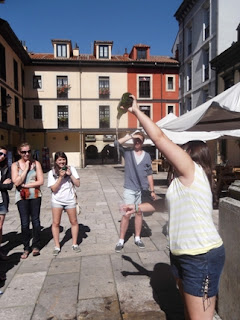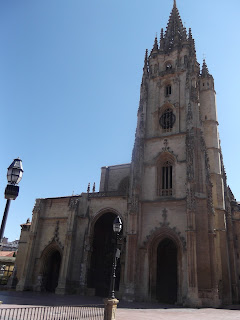Sunday, August 12, 2012
O-my...
As I mentioned earlier, Oviedo is known for its collection of curious statues around the city. Here, you can find everything from a matador's bust in El diestro to William B. Arransberg and (dedicated to travellers) to a Botero nude called Maternidad to a recreation of one of Velazquez's Meninas to Woody Allen. Yes, that's right, Woody Allen - who fell in love with city while filming Vicky Cristina Barcelona here. While the novelty of these creative pieces has worn off for the locals, our students certainly enjoyed seeing - and posing with them. Do not adjust your screens, the last photo is exactly what it looks like.The work of Spanish-Basque artist Eduardo Úrculo, the Culis Monumentalibus does not go unnoticed. Measuring over 13 ft high, the piece was quite controversial when it arrived in the square in 2001.
O..yum!
While Sarah visited the cathedral with the students, Bea and Ron made their way to a nearby sweet shop to puchase a well-known treat for everyone. A little wary after seeing what was offered at the market (whole fish, pigs' trotters, sheeps' brains, etc.), the students weren't sure what to expect when they were told they'd be trying "something typical from Oviedo." Needless to say, when Bea opened the box to reveal rows of puff pastry filled with almonds, eggs and sugar (known as carbayones), they were quickly convinced - and READY to eat!
O...o...Oviedo...
Uncharacteristically warm (and sunny!) our group had the perfect day for our journey north. After learning to escansear sidra in a plaza, trekking through the local market and viewing some, ahem, of the usual statues that mark Oviedo's streets - we made a stop for "story time" with the La Regenta, known throughout Asturias for her romantic antics and certainly no stranger to scandal. In the picture, you can see Bea and her assistant summarizing the timeless drama, and both were sure to point out the importance of the cathedral's tower to the story (seen behind).
Intrigued by her story, the rest of the students decided to pose with notorious Regenta as well before we made our visit to the cathedral/
Intrigued by her story, the rest of the students decided to pose with notorious Regenta as well before we made our visit to the cathedral/
Sunday, July 22, 2012
Off to Oviedo...
A Monday excursion? Sure, why not?
There´s no better way to start off the week than with morning visit to the capital of Asturias (the region just north of us), Oviedo, and an afternoon spent on one of the Costa Verde´s beaches. Even the normally temperamental Asturian climate was in our favor for the day, giving us plenty of sunshine and just the slightest breeze.
Our day started with a walking tour of the city, allowing us to visit the bustling local market, cathedral and some of the city´s best-known statues before students were given a bit of free time to get to know Oviedo on their own. In the market, students were in awe of both the variety of foods offered and their presentation, as some of them hadn´t yet seen a fish in it´s entirety or dared to get close enough to one famed Iberian hams.
Next, we made a brief stop in a small plaza where Ron taught the students (and an additional instructor or two) how to escancear, or properly pour cidra, the traditional beverage of Asturias. While onlookers commented on technique, our students tried to figure out why pouring wasn´t as easy as it looked. Needless to say, there were a lot of laughs to be had and a few pairs of wet shoes by the the time we had to move on. Good thing it was just water!
Following our quick lesson in cidra, we made our way toward the cathedral and La Regenta, a true character in the history of Oviedo.
The Catedral de San Salvador was completed in the 16th century but the original church dates back to the 8th century.
Friday, July 20, 2012
Sunny Salamanca - Part 6
These are some of the other sites in Salamanca that students saw on our walking tour and during their gincana.
And last but not least, a statue recognizing one of the city´s most-famed characters, Lazarillo de Tormes, whose story is said to be the precursor for what is now known as the picaresque novel.
The puente romana, or Roman bridge, that spans the Río Tormes.
The Museo Casa Lis, also known as the Museo de Art Nouveau-Art Déco
And last but not least, a statue recognizing one of the city´s most-famed characters, Lazarillo de Tormes, whose story is said to be the precursor for what is now known as the picaresque novel.
Sunny Salamanca - Part 5
Apart from the frog, another figure often associated with the famed university is Fray Luis de León. As a Hebrew scholar, he worked at the university and was later arrested for heresy. He was imprisoned for 5 years, but returned to the university after being cleared and is rumored to have started his first lecture: "as I was saying yesterday..."
Sunny Salamanca - Part 4
The next stop on our tour was to the famed Universidad de Salamanca where Erin explained the intricate entranceway and some of the lore assoicated with the popular symbol of the city, the frog, whose diminuitive size provides a challenge for even the sharpest eye to find. Can you see it? :)
Sunny Salamanca - Part 3
This is the facade of the other university in Salamanca, the esteemed but lesser-known Universidad Pontificia de Salamanca.
Following the gincana, the students went on a brief walking tour to see some of places they learned about in their culture class. The first stop? La casa de conchas, a 15th century home that is reconized for its distinct appearance, featuring more than 300 shells on its exterior. The home, located across from the Universidad Pontificia, was originally created as a monument to Santiago de Compostela (hence the scallop shell, which is the symbol most commonly associated with the Camino of Santiago that many pilgrims and tourists alike take each year).
There are many folklores associated with the Casa, but the students were most interested in the one that alluded to gold being hidden under some of the shells. I think I saw a few hands go up when I asked if there was anyone who was willing to spend a few more hours in the salamantino sun to try and find it. :)
Following the gincana, the students went on a brief walking tour to see some of places they learned about in their culture class. The first stop? La casa de conchas, a 15th century home that is reconized for its distinct appearance, featuring more than 300 shells on its exterior. The home, located across from the Universidad Pontificia, was originally created as a monument to Santiago de Compostela (hence the scallop shell, which is the symbol most commonly associated with the Camino of Santiago that many pilgrims and tourists alike take each year).
There are many folklores associated with the Casa, but the students were most interested in the one that alluded to gold being hidden under some of the shells. I think I saw a few hands go up when I asked if there was anyone who was willing to spend a few more hours in the salamantino sun to try and find it. :)
Sunny Salamanca - Part 2
Not long after arrival in the sunny university city, students were given a little free time to take in some of the many historical sites and indulge in what has become a favorite passtime, ir de compras (shopping). As it is currently the season of the rebajas (or sales) many returned to our meeting point in the beautiful-yet-imperfect Plaza Mayor with a bag, or two.
These girls each found a special souvenir, an imán (magnet) featuring a Euro coin and the symbol of Salamanca, a small frog that´s rumoured to bring good luck.
As the many of the stores in Salamanca close during the traditional siesta, the students were ready to embark upon their next adventure after eating lunch. Armed with maps and nearly 5 weeks of Spanish-immersion, they took to the streets in small groups with their list of questions to be answered. Covering the city by foot, they had to rely on the locals to help them in their attempts to be the first in completing the gincana (a type of treasure hunt). Shown below are our two winning teams.
And their efforts did not go unrewarded. Each of our winners was given a key chain with an emblem representative of the city, ranging from the artistic symbol of the charra, the facade of the cathedral, Plaza Mayor and of course, something from the famed university. The favorite? A small skull with the aforementioned lucky frog. Who would´ve thought? :)
These girls each found a special souvenir, an imán (magnet) featuring a Euro coin and the symbol of Salamanca, a small frog that´s rumoured to bring good luck.
As the many of the stores in Salamanca close during the traditional siesta, the students were ready to embark upon their next adventure after eating lunch. Armed with maps and nearly 5 weeks of Spanish-immersion, they took to the streets in small groups with their list of questions to be answered. Covering the city by foot, they had to rely on the locals to help them in their attempts to be the first in completing the gincana (a type of treasure hunt). Shown below are our two winning teams.
And their efforts did not go unrewarded. Each of our winners was given a key chain with an emblem representative of the city, ranging from the artistic symbol of the charra, the facade of the cathedral, Plaza Mayor and of course, something from the famed university. The favorite? A small skull with the aforementioned lucky frog. Who would´ve thought? :)
Saturday, July 14, 2012
Sunny Salamanca
On Friday, we headed with the students to the ancient city of Salamanca, home of the oldest university in Spain and once the greatest in all of Europe.
Our first stop in Salamanca was the cathedral, or should I say cathedrals, as the new was constructed alongside the old. Here´s Ron explaining a little of the cathedrals´ unique history.
Construction on the catedral vieja, or old cathedral, first began in 1140. And though its interior decoration is quite different to that of its more modern counterpart, the students enjoyed being able to travel back in time, viewing the many chapels (including the one where final exams were once given to university students) and also the cloisters.
Our first stop in Salamanca was the cathedral, or should I say cathedrals, as the new was constructed alongside the old. Here´s Ron explaining a little of the cathedrals´ unique history.
The students are outside the catedral nueva, or new cathedral, which took over 200 years to complete and displays elements of many architectural styles including Gothic, Baroque and Plateresque. Below, you can see some additional shots of the cathedral including the tower, which some of our students climbed to get a better view of the city.
Be sure to ask your student about the "unique" piece that was added to the exterior of the new cathedral! :)
Construction on the catedral vieja, or old cathedral, first began in 1140. And though its interior decoration is quite different to that of its more modern counterpart, the students enjoyed being able to travel back in time, viewing the many chapels (including the one where final exams were once given to university students) and also the cloisters.
Subscribe to:
Posts (Atom)











































